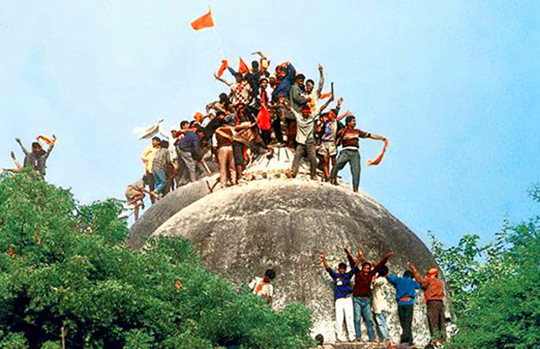After the long wait, the Supreme Court Chief Justice J.S. Khehar opined that long pending dispute of Ram Janmabhoomi-Babri Masjid should be settled out of court. (March 2017) He even offered to mediate himself in the matter. Uniformly most of the spokesperson from RSS Combine welcomed the move, while large number of Muslims and other elements have been surprised as the Court was approached for justice and not or compromise formula.

This is in the backdrop of the judgment of Lukhnow branch of Allahabad Court (2010). As per this, the three judge bench had said that the land should be divided into three parts. As such the judgment was an exercise of sorts trying to do a balancing act between all the parties involved, Ram Lalla Virajman, Nirmohi Akhada and Sunni wakf board. The title of the land has been divided into three; each sharing one part. Also court had declared since Hindus believe that the ‘birth place’ of Lord Ram to be below the place where the central dome of the mosque stood, that place should be allotted to Hindus. In response RSS chief in a jubilant mood had proclaimed that now the path for a grand Ram temple has been opened at the site and all the parties should cooperate in this “national” work.
For larger sections this judgment came as a matter of dismay. The Babri Mosque has been there from last nearly five hundred years and it was in possession of Sunni Waqf Board. The dispute was created in nineteen century. In 1885 even the court denied Hindus to build shed on the platform outside the mosque. It is after the forcible installation of Ram Lalla idols (1949) that the matters went in an adverse way. Through a conspiracy; the idols were installed and despite the insistence of Pundit Jawaharlal Nehru, the then Prime Minister of India, the UP administration did not comply. The gates of the masjid were sealed. It was in 1986 that Rajiv Gandhi, the then Prime Minister, got the doors of the Masjid opened under the intense pressure of Hindu Right wing forces.
Lal Krishna Advani took up the issue from VHP, which was agitating for Ram Temple so far. With Advani, the President of BJP, taking up the issue its political impact started deepening and widening at the same time. It was made the major polarizing issue around which consolidation of Hindu vote bank began. The mobilization for Rath yatra planned for the temple movement became much more in the aftermath of Mandal Commission implementation. Those who opposed reservation for OBCs came forward in large numbers in the mobilization for Ram Temple.
While BJP did not show direct opposition to Mandal commission, it converted the opposition in to the Ram Temple issue. Mandal versus Kamandal (Holy water pot, Religiosity), is how some framed it.
This issue came up to torment the delicate thread of peace prevailing in the society. The culmination this campaign was in the form of demolition of the Babri Masjid. In the demolition RSS combine mobilized large section of people and Narsimha Rao colluded. While local administration collapsed, Kalyan Singh of BJP, who was then Chief Minister of UP, facilitated the assembly of kar sevaks, which was to demolish the mosque. He did this despite his promise to Supreme Court that he will protect the mosque. Narsimha Rao who locked himself in his Puja room as the mosque was being demolished later promised that it will be built precisely at the same spot.
The matters took the turn for the worse as BJP led team of ‘archeologists-Kar Sevaks’ tried to prove that there are remnants of Ram Temple below the mosque. Archeologically this is not tenable. That there was no convincing proof of Ram Temple underneath becomes clear from the fact the High Court Bench had to resort to ‘faith of Hindus’ to allot 2/3 of the land to Hindu groups. The demolition of Mosque might have been the biggest crime in India and that was well planned. Despite that the leaders of demolition squad have not been punished so far.
Liberhan Commission did point out the nature of underlying conspiracy but unfortunately the Commission took long to submit its report. To add salt to the injury Advani and company became stronger after this crime against the nation. The demolition also unleashed massive violence against Muslims, particularly in Mumbai, Bhopal and Surat along with other places. The guilty of this violence have also been let off totally or with minor reprimand.
In the matter of this dispute the ownership of the title has been the real issue. The High Court based itself more on ‘Faith’ than the records of ownership of the land. The Supreme Court as the highest legal body needs to see the total issue from legal angle and needs to set right the wrongs done so far. Only concrete legal aspects should determine the outcome of the case. Instead to call for compromise out of Court in present circumstances is overlooking the aspect of justice. In out of Court settlement already the Hindu groups have said that Muslims should leave the place for Ram Temple and another suitable land will be given to them for mosque. The two sides are not evenly balanced as far as their strength on negotiating table is concerned.
There are threats from the likes of Subramanian Swami, BJP MP, and others that if Muslims don’t give up their claim, the bill will be brought through Parliament once BJP has bigger strength. The threats of this type are immoral. Already there are claims on so many Mosques to convert them into temples! In the out of Court settlement, the Hindu nationalists are more assertive and dominant while the representatives of Muslims are being pushed into a corner that does not augur well for the health of our democracy. Effort to revive issue of other mosques is unwarranted and intimidating to minorities. That needs to be stopped.








Comments
Add new comment